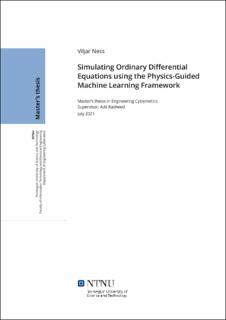| dc.contributor.advisor | Rasheed, Adil | |
| dc.contributor.author | Ness, Viljar | |
| dc.date.accessioned | 2021-11-09T18:21:28Z | |
| dc.date.available | 2021-11-09T18:21:28Z | |
| dc.date.issued | 2021 | |
| dc.identifier | no.ntnu:inspera:76427839:32749721 | |
| dc.identifier.uri | https://hdl.handle.net/11250/2828774 | |
| dc.description.abstract | Den økende mengden med tilgjengelig måledata har gjort at data-drevet modellering og maskin læring har blitt populære metoder. Disse metodene har noen svakheter. De har mye uforklarlighet, og er ikke veldig generaliserende. I denne avhandlingen er fysikk-drevet maskin læring brukt til å lage neurale nettverk som bruker informasjon fra fysikk-baserte ligninger. De resulterende hybridmodell neurale nettverka, kalt fysikk drevet neurale nettverk i denne avhandlingen, er brukt til å simulere ordinære differensiallikninger. Duffing ligningen og Rayleigh-Plesset ligningen er brukt for å teste nettverka. Resultatene tilsier at fysikk-drevet neurale nettverk har høyere treffsikkerhet og mindre varians enn dype neurale nettverk, selv med færre lag enn det tilsvarende dype nettverket. Dette gir nettverk som presterer bra, samtidig som det er mindre trenbare parametere. Ved å ha mindre trenbare parametere får man nettverk som er mer forklarbare. Det har også blitt gjennomført utforskning på hvordan egenskapene til differensial ligningene påvirker nettverkets prestasjon. | |
| dc.description.abstract | The expanding amount of available data from measurements have made data-driven modeling and machine learning popular approaches to modeling. However, these methods often come with the disadvantages of having low explainability and lack generalizability. In this thesis the physics-guided machine learning framework is used to create neural networks which utilizes information from physics-based modeling. These hybrid-model neural networks, called physics-guided neural network in this thesis, are used to predict ordinary differential equations in a simulation setup. The equations that are used for testing are the Duffing equation and the Rayleigh-Plesset equation. The results from this shows that physics-guided neural networks can give higher accuracy and less uncertainty than deep neural networks even with less layers. This gives accurate networks that are less complex with less trainable parameters, and thus increasing the explainability of the models. It is also shown that the characteristics of the ordinary differential equations has effect on how much the insertion of some known equation knowledge affect the performance. | |
| dc.language | eng | |
| dc.publisher | NTNU | |
| dc.title | Simulating Ordinary Differential Equations using the Physics-Guided Machine Learning Framework | |
| dc.type | Master thesis | |
